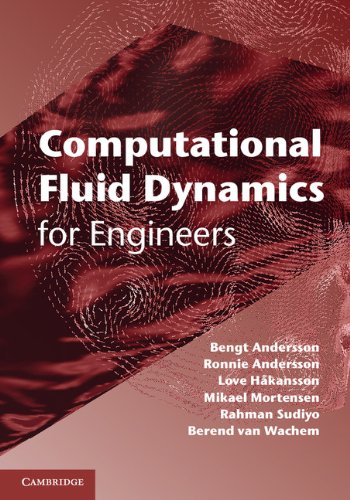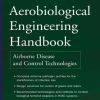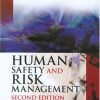Computational Fluid Dynamics for Engineers 1st Edition by Bengt Andersson, Ronnie Andersson, Love Håkansson, Mikael Mortensen, Rahman Sudiyo, Berend van Wachem 9781139199865 1139199862
$50.00 Original price was: $50.00.$35.00Current price is: $35.00.
Computational Fluid Dynamics for Engineers 1st Edition by Bengt Andersson, Ronnie Andersson, Love Håkansson, Mikael Mortensen, Rahman Sudiyo, Berend van Wachem – Ebook PDF Instant Download/Delivery: 9781139199865, 1139199862
Full download Computational Fluid Dynamics for Engineers 1st Edition after payment

Product details:
ISBN 10: 1139199862
ISBN 13: 9781139199865
Author: Bengt Andersson, Ronnie Andersson, Love Håkansson, Mikael Mortensen, Rahman Sudiyo, Berend van Wachem
Computational fluid dynamics, CFD, has become an indispensable tool for many engineers. This book gives an introduction to CFD simulations of turbulence, mixing, reaction, combustion and multiphase flows. The emphasis on understanding the physics of these flows helps the engineer to select appropriate models to obtain reliable simulations. Besides presenting the equations involved, the basics and limitations of the models are explained and discussed. The book combined with tutorials, project and power-point lecture notes (all available for download) forms a complete course. The reader is given hands-on experience of drawing, meshing and simulation. The tutorials cover flow and reactions inside a porous catalyst, combustion in turbulent non-premixed flow, and multiphase simulation of evaporation spray respectively. The project deals with design of an industrial-scale selective catalytic reduction process and allows the reader to explore various design improvements and apply best practice guidelines in the CFD simulations.
Computational Fluid Dynamics for Engineers 1st Table of contents:
1 Introduction
1.1 Modelling in engineering
1.2 CFD simulations
1.3 Applications in engineering
1.4 Flow
1.4.1 Laminar flow
1.4.2 Turbulent flow
1.4.3 Single-phase flow
1.4.4 Multiphase flow
1.5 CFD programs
2 Modelling
2.1 Mass, heat and momentum balances
2.1.1 Viscosity, diffusion and heat conduction
2.2 The equation of continuity
2.3 The equation of motion
2.4 Energy transport
2.4.1 The balance for kinetic energy
2.4.2 The balance for thermal energy
2.5 The balance for species
2.6 Boundary conditions
2.6.1 Inlet and outlet boundaries
2.6.2 Wall boundaries
2.6.3 Symmetry and axis boundary conditions
2.6.4 Initial conditions
2.6.5 Domain settings
2.7 Physical properties
2.7.1 The equation of state
2.7.2 Viscosity
3 Numerical aspects of CFD
3.1 Introduction
3.2 Numerical methods for CFD
3.2.1 The finite-volume method
3.2.2 Geometrical definitions
3.3 Cell balancing
3.3.1 The convective term
3.3.2 The diffusion term
3.3.3 The source term
3.4 Example 1 – 1D mass diffusion in a flowing gas
3.4.1 Solution
3.4.2 Concluding remarks
3.5 The Gauss–Seidel algorithm
3.6 Example 2 – Gauss–Seidel
3.7 Measures of convergence
3.8 Discretization schemes
3.8.1 Example 3 – increased velocity
3.8.2 Boundedness and transportiveness
3.8.3 The upwind schemes
3.8.4 Taylor expansions
3.8.5 Accuracy
3.8.6 The hybrid scheme
3.8.7 The power-law scheme
3.8.8 The QUICK scheme
3.8.9 More advanced discretization schemes
3.9 Solving the velocity field
3.9.1 Under-relaxation
3.10 Multigrid
3.11 Unsteady flows
3.11.1 Example 4 – time-dependent simulation
3.11.2 Conclusions on the different time discretization methods
3.12 Meshing
3.12.1 Mesh generation
3.12.2 Adaptation
3.12.3 Numerical diffusion
3.13 Summary
4 Turbulent-flow modelling
4.1 The physics of fluid turbulence
4.1.1 Characteristic features of turbulent flows
4.1.2 Statistical methods
4.1.3 Flow stability
4.1.4 The Kolmogorov hypotheses
4.1.5 The energy cascade
4.1.6 Sources of turbulence
4.1.7 The turbulent energy spectrum
4.2 Turbulence modelling
4.2.1 Direct numerical simulation
4.2.2 Large-eddy simulation
4.2.3 Reynolds decomposition
4.2.4 Models based on the turbulent viscosity hypothesis
4.2.5 Reynolds stress models (RSMs)
4.2.6 Advanced turbulence modelling
4.2.7 Comparisons of various turbulence models
4.3 Near-wall modelling
4.3.1 Turbulent boundary layers
4.3.2 Wall functions
4.3.3 Improved near-wall-modelling
4.3.4 Comparison of three near-wall modelling approaches
4.4 Inlet and outlet boundary conditions
4.5 Summary
5 Turbulent mixing and chemical reactions
5.1 Introduction
5.2 Problem description
5.3 The nature of turbulent mixing
5.4 Mixing of a conserved scalar
5.4.1 Mixing timescales
5.4.2 Probability density functions
5.4.3 Modelling of turbulent mixing
5.5 Modelling of chemical reactions
5.5.1 Da ≪ 1
5.5.2 Da ≫ 1
5.5.3 Da ≈ 1
5.6 Non-PDF models
5.7 Summary
6 Multiphase flow modelling
6.1 Introduction
6.1.1 Characterization of multiphase flows
6.1.2 Coupling between a continuous phase and a dispersed phase
6.2 Forces on dispersed particles
6.3 Computational models
6.3.1 Choosing a multiphase model
6.3.2 Direct numerical simulations
6.3.3 Lagrangian particle simulations, the point-particle approach
6.3.4 Euler–Euler models
6.3.5 The mixture model
6.3.6 Models for stratified fluid–fluid flows
6.3.7 Models for flows in porous media
6.4 Closure models
6.4.1 Interphase drag
6.4.2 Particle interactions
6.4.3 Heat and mass transfer
6.5 Boundaries and boundary conditions
6.5.1 Lagrangian dispersed phase
6.5.2 Eulerian dispersed phase
6.6 Summary
6.6.1 Guidelines for selecting a multiphase model
7 Best-practice guidelines
7.1 Application uncertainty
7.1.1 Geometry and grid design
7.2 Numerical uncertainty
7.2.1 Convergence
7.2.2 Enhancing convergence
7.2.3 Numerical errors
7.2.4 Temporal discretization
7.3 Turbulence modelling
7.3.1 Boundary conditions
7.4 Reactions
7.5 Multiphase modelling
7.6 Sensitivity analysis
7.7 Verification, validation and calibration
People also search for Computational Fluid Dynamics for Engineers 1st:
omputational fluid dynamics for chemical engineers
computational fluid dynamics an introduction for engineers
computational fluid dynamics in aerospace engineering
computational fluid dynamics jobs
computational fluid dynamics examples
Tags: Computational, Fluid Dynamics, Bengt Andersson, Ronnie Andersson, Love Håkansson, Mikael Mortensen, Rahman Sudiyo, Berend van Wachem



